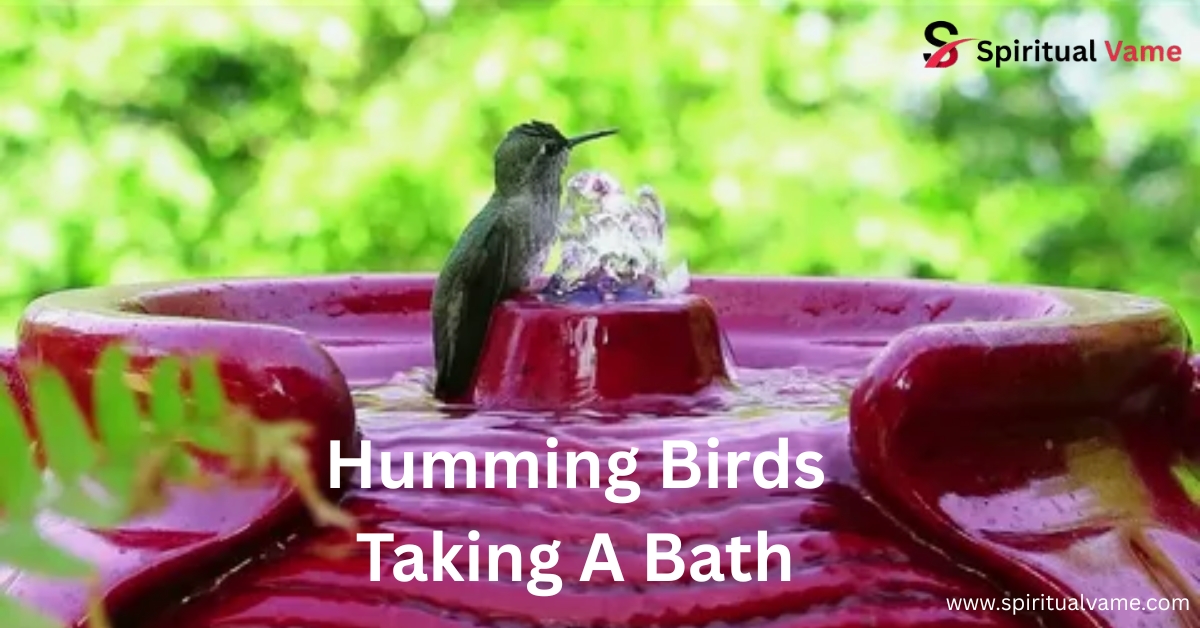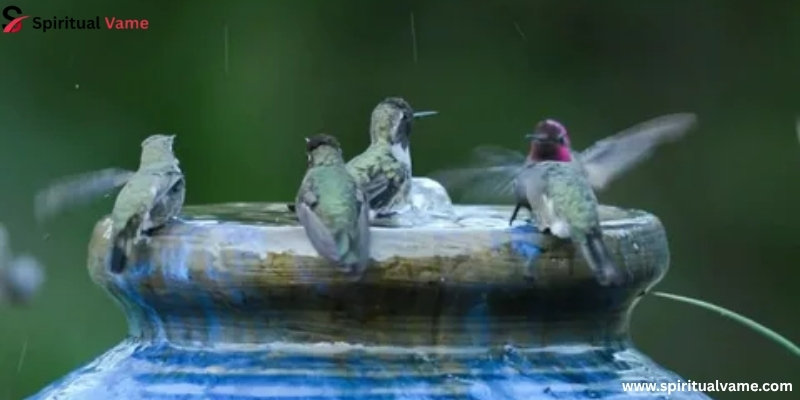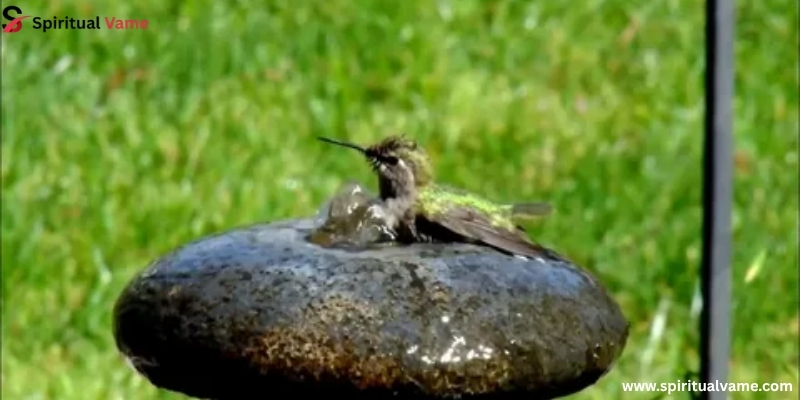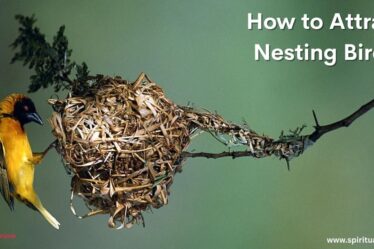
Do hummingbirds use bird baths? It’s a question many backyard bird lovers ask. These tiny birds are known for sipping nectar, but they need water too. Just like other birds, hummingbirds need clean water to bathe and stay cool. A bird bath can be a great way to help them. But do they really use it?
The answer is yes—if it’s the right kind. Do hummingbirds use bird baths with still water? Not often. They prefer moving water like a mister, dripper, or fountain. The spray and mist help clean their feathers. If you set it up correctly, you’ll soon see them splashing around. So yes, hummingbirds do enjoy a good bird bath!
Will a Hummingbird Use a Bird Bath
Yes, hummingbirds absolutely use birdbaths—just not the way most people expect. These tiny birds don’t land in deep pools like a robin would. Instead, they enjoy darting through fine sprays, hovering over ripples, or quickly dipping into shallow water to flutter and shake. This helps them stay cool and clean, especially during hot season changes when heat, stress, and panting can affect their health.
They use water not for drinking but to clean their plumage and remove dirt or parasites. Clean feathers are essential for flight and insulation. A good bath lets them preen their delicate wings and keep them in top condition for their high-energy lifestyle, which includes chasing protein-packed insects and defending their territory with surprising aggression.
How to Set Up a Hummingbird Bird Bath
To attract hummingbirds, set up a birdbath that’s shallow, clean, and has some sort of gentle movement. They don’t like still water and are more drawn to sprays, light mist, or gentle drippers that mimic natural sources. A wide, shallow basin with a solar-powered pump can create that perfect ripple effect, and placing it near blooming native plants and flowers will make it even more inviting.
Use materials like smooth rocks or flat surfaces in the basin to give them safe spots to land briefly if needed. Bright colors like red or tubular designs can also catch their attention, as these mimic the nectar-rich blooms they naturally visit. Make sure there’s enough visibility and accessibility so they can see the water and feel safe approaching it.
How to Maintain a Hummingbird Bird Bath
Do hummingbirds use bird baths? Maintenance is key. Hummingbirds won’t return to a dirty birdbath, and stagnant water can quickly become unsafe. You should clean the bath every few days, especially in warm weather when algae or bacteria grow fast. Use fresh, cool water, scrub with a gentle brush, and avoid any chemical cleaners that could harm their delicate feathers.
Regular maintenance also helps prevent mosquitoes from laying eggs, which can turn your inviting garden into a breeding ground. A solar-powered pump or a simple dripper keeps the water moving and fresh. Do hummingbirds use bird baths regularly? Only if the setup stays clean and safe. Remember, keeping things clean and in good condition also helps protect other wildlife and promotes a healthy environment in your landscaping. That’s why answering do hummingbirds use bird baths depends largely on how well it’s maintained.
Place Perches Nearby
After bathing, hummingbirds love a safe place to rest and preen their plumage. Placing small perches near the birdbath gives them space to dry off and groom their feathers. These could be thin branches, metal rods, or even decorative garden hooks.
Perches should be placed where birds have a clear view of their surroundings to watch for predators, but also where there’s some shade so they don’t overheat. These rest spots are just as important as the bath itself, especially for birds that bathe multiple times a day to keep their flight efficient and their body temperature regulated.
Clean Your Hummingbird Bird Bath Frequently
A dirty birdbath is worse than no bath at all. Without regular cleaning, harmful bacteria and algae build up fast—especially when the weather is warm. This can make birds sick or attract the wrong kind of visitors. That’s why a consistent cleaning routine is vital. Empty the basin, rinse it with fresh water, and use a small brush to scrub away any buildup.
Stick to natural cleaners like diluted vinegar when needed. Avoid harsh soaps or chemicals. Also, check that your pump, solar features, and drippers are working well. Frequent cleaning also helps with better visibility and makes the bath look more appealing to all hummingbirds in the area.

How to Attract Hummingbirds With Water or Baths
Movement is the secret ingredient. A still pool of water won’t impress a hummingbird, but a soft spray, mister, or light dripper is irresistible. These mimic rain or dew—natural things that hummingbirds already use to clean themselves in the wild. You can buy solar-powered fountains, or even DIY a version using a hanging bottle and tiny holes.
Location matters too. Place your water feature where it’s surrounded by flowers, shrubs, and native plants, giving birds food and cover. Ideally, it should be within view of existing feeders, so the birds feel like it’s part of their familiar territory. Keep the bath low to the ground, yet visible, and avoid high-traffic areas.
Hummingbirds and Water
Water is vital to a hummingbird‘s health. While they get hydration from nectar and tiny insects, they also need fresh water for bathing and preening. When they fly through droplets or perch under a mister, they’re not just playing—they’re cooling down and protecting their feathers from damage and buildup.
In hot months, their small size makes them vulnerable to heat, stress, and even lethargy. That’s why regular access to cool, moving water helps prevent panting and other signs of overheating. It also gives them the energy boost needed for catching spiders, finding nesting material, and raising their young during the brooding season.
Providing Water for Hummingbirds
Even if you don’t have a fancy birdbath, you can still offer water with a few clever ideas. Hanging misters, small fountains, or dripping hoses can create the exact kind of motion hummingbirds love. You could even gently spray a leafy bush and watch them fly through the droplets.
It’s not about quantity—it’s about how natural it feels. A single leaf with mist, a flat rock with shallow water, or even a decorative basin placed near red blooms can make all the difference. These small gestures help with their overall hydration and health while adding magic to your backyard.
Keeping Water Sources Safe
Your goal is to create a safe space. This means no chemicals, no mold, and definitely no predators. Avoid placing the birdbath near thick underbrush where cats or snakes could hide. Make sure birds have open space to escape if needed, but also some trees or shrubs nearby for cover.
Regularly inspect the water for cleanliness. If you notice mosquitoes, empty and scrub the basin immediately. If a sick bird visits, clean everything thoroughly and let it dry before refilling. If you ever find an injured or very tired hummingbird, call a licensed rehabilitator or contact a local bird sanctuary with the proper permit to help them recover.

Key Features of a Hummingbird Bird Bath
The perfect hummingbird birdbath includes several key features: it must be shallow, offer some kind of water movement, and provide safe perches nearby. These perches are essential for grooming and resting, especially after a good bathing session. They’ll often preen their feathers, fluff up, and stretch their wings right after. The bath should be placed where the birds can see clearly and escape if a predator approaches—so both visibility and accessibility matter.
Other important elements include a gentle spray or mist created by a solar-powered pump, a smooth basin that’s easy to clean, and thoughtful placement in a partially shaded area. Sunlight helps attract the birds and keeps the water warm, but too much direct light can lead to quick evaporation or algae buildup.
Pick a Bright-Colored Bath, Like Red
Hummingbirds are naturally drawn to the color red, so incorporating that hue into your birdbath is a smart move. Whether it’s the actual basin, a decorative rock, or even a nearby flowerpot, this vibrant color acts like a neon sign to passing birds. It signals a potential nectar source, and once they investigate, they might discover the water feature and stick around.
Pairing the bath with red tubular flowers—like bee balm or cardinal flower—makes your backyard even more appealing. This combination of color and function taps into the hummingbird’s instincts, encouraging them to visit and return frequently.
Keep the Bird Bath Shallow
Depth is one of the most important details. A birdbath that’s more than one inch deep is usually too much for hummingbirds. Their legs are tiny, and they don’t wade or stand in water like larger birds. Instead, they like to hover just above the water or skim across it. A shallow bath, around ½ to 1 inch deep, is perfect.
You can add a rock or even a tilted leaf inside the bath to create a gentle slope and give them a safe surface to land on. This helps them feel more confident approaching the water. It also makes cleaning easier, reducing maintenance and keeping your setup fresh and welcoming.
Add Misters, Drippers and Fountains to Bird Baths
Hummingbirds love the sound and sight of moving water. Adding devices like misters, drippers, and fountains helps replicate the conditions they find in the wild. Not only do these make your water feature more visually interesting, but they also keep the water fresh and prevent mosquito larvae from taking hold.
Misters
A mister creates a fine spray that hummingbirds enjoy flying through. It mimics the soft feel of a light rain or dewy droplets on a leaf. Place your mister near flowers, or even let it mist onto a shrub or tree, and you’ll often see birds darting in and out of the mist throughout the day.
Fountains
A small fountain, especially one with a bubbling or trickling feature, adds both sound and movement. Look for one with a solar panel and gentle flow—too much pressure can scare off the birds. Fountains with adjustable settings are ideal because you can control the strength of the spray.
Drippers
Drippers release small drops at a steady rate. The sound of water tapping on a rock or pooling into the basin attracts curious hummingbirds. You can buy drippers online or even make your own using a bucket with a small hole. It’s a simple and effective upgrade to any birdbath.
Make Your Own Bird Bath
You don’t have to spend a lot to make a hummingbird-friendly bath. A shallow dish, like a clay saucer or old pie tin, can work as a basin. Place it on top of an overturned flowerpot or hang it using wire and hooks. Just be sure to add some pebbles or a rock to give the birds a place to perch.
A DIY mister can be made from a bottle with pinholes or a hose on low pressure. Add bright colors nearby and position your bath in partial shade to prevent algae growth. Homemade baths often work just as well as store-bought ones if you focus on the right features: shallow depth, cleanliness, and movement.
Add Perches for Preening, Drying
Do hummingbirds use bird baths just for a quick splash? Not quite. Once hummingbirds finish bathing, they need a nearby perch to sit, shake out their feathers, and start preening. This grooming process helps them keep their plumage smooth, aligned, and waterproof. Without it, their flight would suffer, and they’d burn more energy in the air.
You can use thin branches, bamboo stakes, or decorative wires to make perches. Make sure they’re spaced out and not too close to the water to avoid splashing or crowding. If you’re wondering, do hummingbirds use bird baths often, the answer depends on how safe and well-designed the space is—including places to rest. Ultimately, do hummingbirds use bird baths comes down to comfort, safety, and thoughtful setup.
Keep Bird Baths Safe, Clean Year-Round
Birdbaths aren’t just a summer project. Hummingbirds need clean water all season long, especially during migration when their need for hydration, energy, and rest peaks. In cooler months or rainy seasons, empty the bath regularly to remove debris and check for standing water that may harbor bacteria.
Using a solar pump helps keep things moving year-round without needing electricity. Always check for wear and tear on your bath’s parts, like the pump, mister, or dripper, and clean them out regularly to avoid blockages. A clean bath with year-round maintenance shows you care about your garden’s wildlife and helps build a safe sanctuary for more than just hummingbirds.
Where to Place a Bird Bath
Placement is everything. Put your birdbath where hummingbirds will feel safe and comfortable. That means close to flowers, feeders, and shrubs, but not right in the middle of the action. Ideally, it should be in a quiet area with some shade, but not completely hidden. Visibility helps them spot it while flying, and some sunlight keeps the water from getting too cold.
Avoid placing it under branches where leaves or droppings could fall into the basin. Also, steer clear of high-traffic paths or play areas where the birds could get spooked. Creating a peaceful pocket in your landscaping helps the birds feel at home and encourages repeat visits.

Attract More Hummingbirds With Ideal Birdbath Placement
The more comfortable hummingbirds feel, the more likely they are to return. Place the bath near red flowers, native plants, and other nectar sources. You can even create a small territory for them, spacing out feeders, perches, and bathing areas to reduce aggression among visitors.
Use multiple water features if your yard is big enough. A dripper in one corner, a mister near blooming plants, and a fountain tucked under a tree branch all give options for different bird personalities. Remember, even the shy ones like a good splash!
Keep Hummingbirds Safe From Predators
Safety comes first. Never place your birdbath too close to thick bushes or the ground where predators like cats could hide. Keep the area open but provide nearby trees or shrubs for cover. Birds want to feel like they can escape in a flash.
Make sure your bath isn’t near reflective windows, which can confuse and harm them. Also, if you see any signs of sick or injured birds, contact a local wildlife rehabilitator or sanctuary. They’ll have the right tools, permit, and cavity–nesting knowledge to help the young or brooding birds recover safely.
Conclusion
Adding a birdbath designed for hummingbirds is one of the easiest and most rewarding ways to bring life, color, and motion into your garden or backyard. These tiny birds don’t just drink—they bathe, preen, and play in the water, especially when it’s delivered in gentle mist, dripper, or fountain form. Whether you choose a store-bought basin or build a DIY one, the key is to keep the water shallow, clean, and in motion. Combine your bath with bright red accents, nearby perches, and blooming native plants, and you’ll create a perfect oasis for these high-energy visitors.
From hydration to feather care, every element matters—visibility, accessibility, shade, safety, and regular maintenance. Your effort not only attracts hummingbirds but also supports their health, especially during times of heat, stress, or migration. With a thoughtful setup, your yard becomes more than a space—it transforms into a mini sanctuary where hummingbirds can thrive, sparkle, and return year after year.



